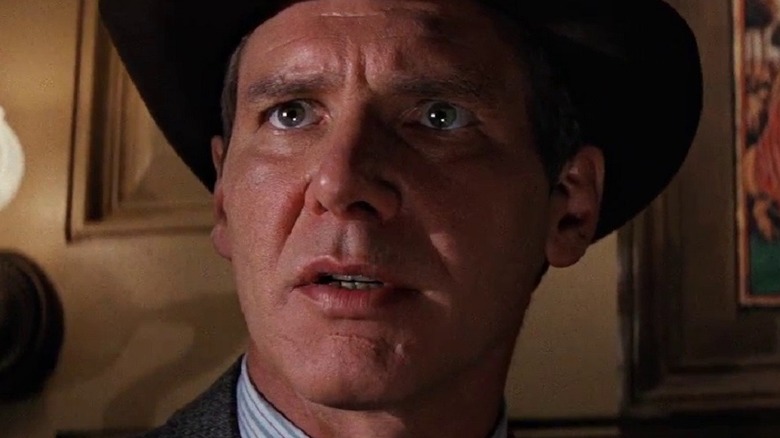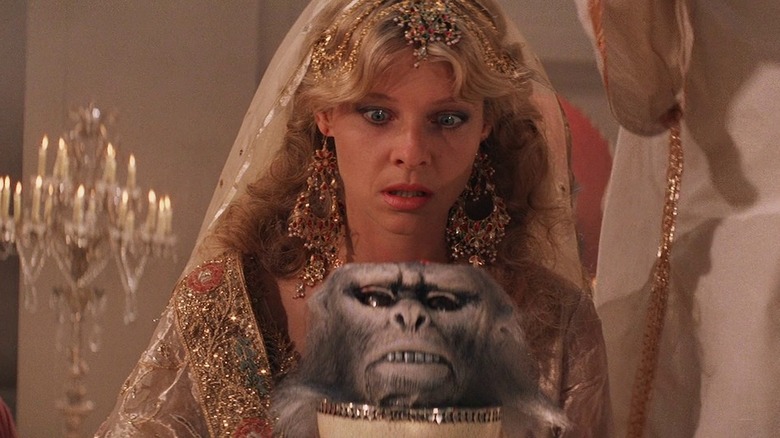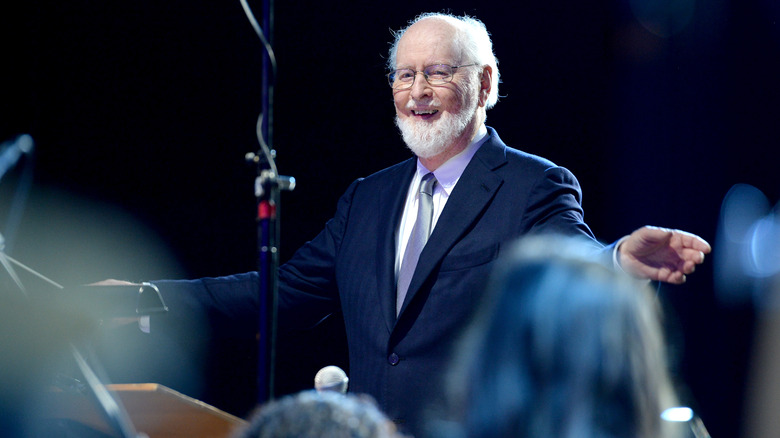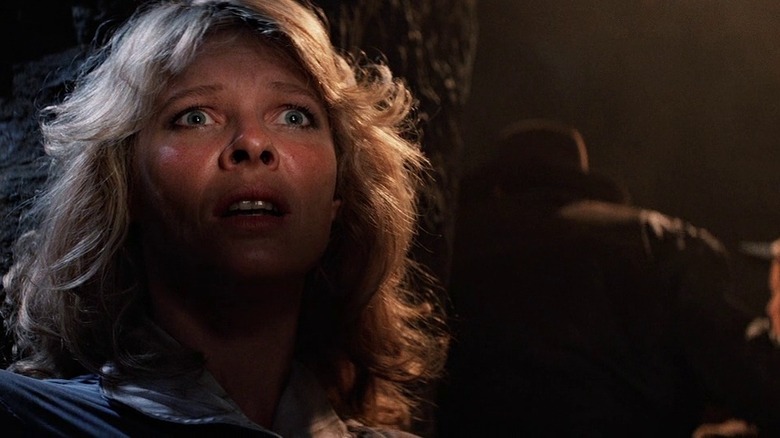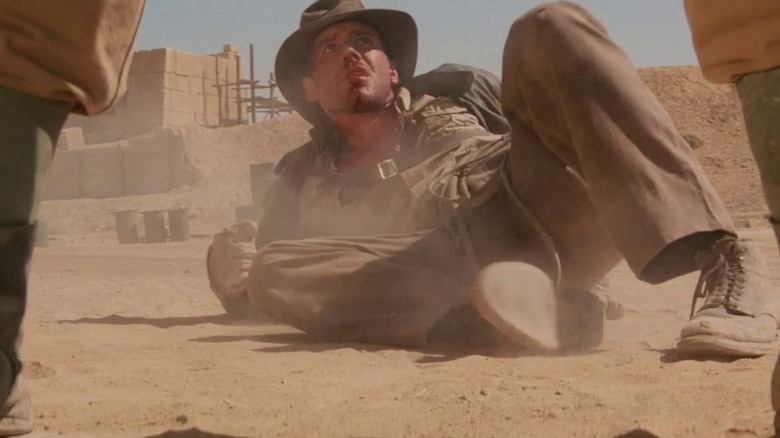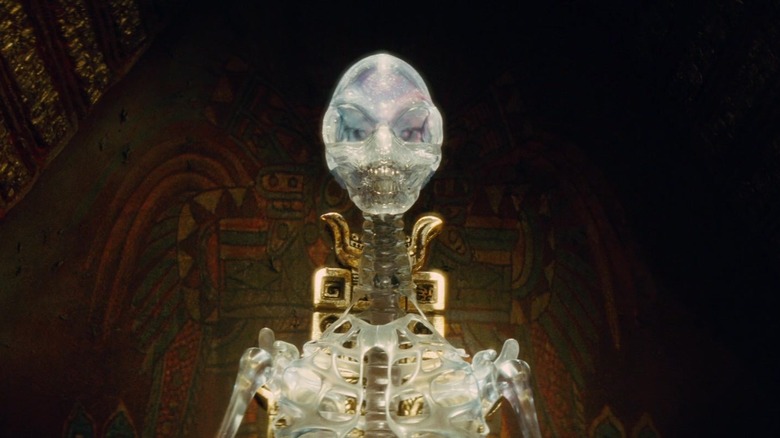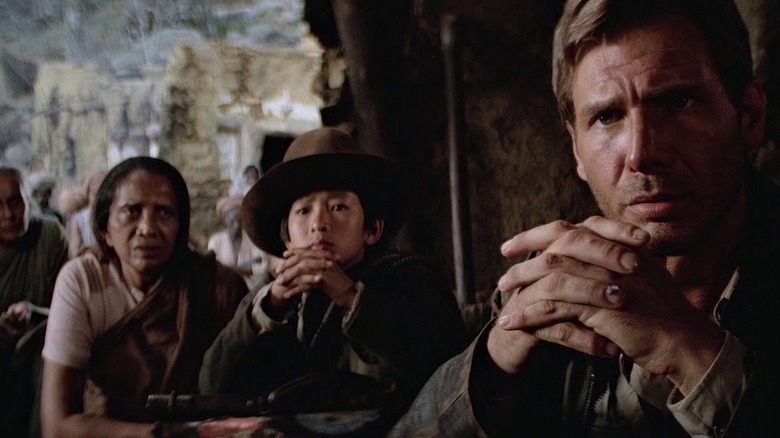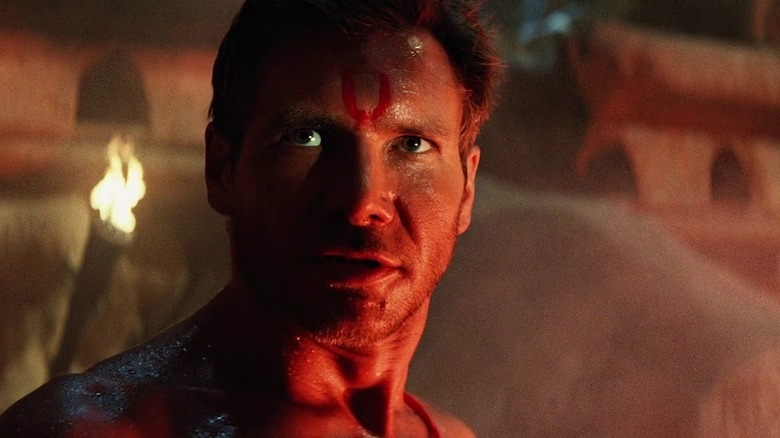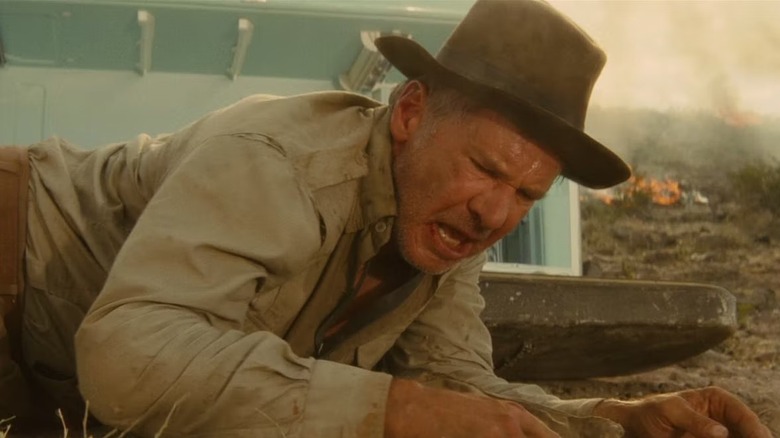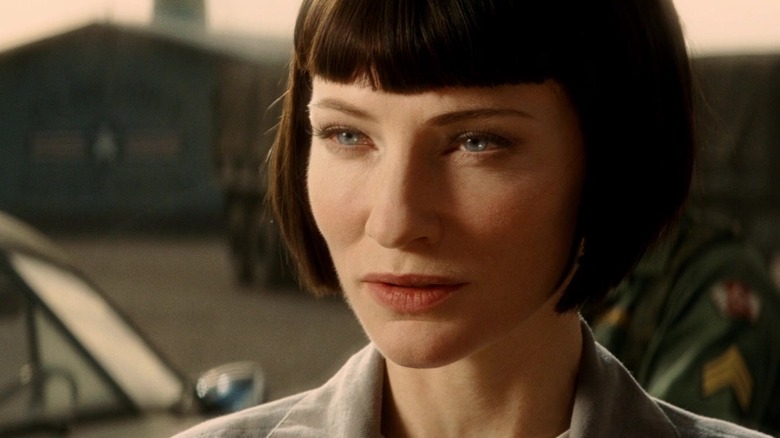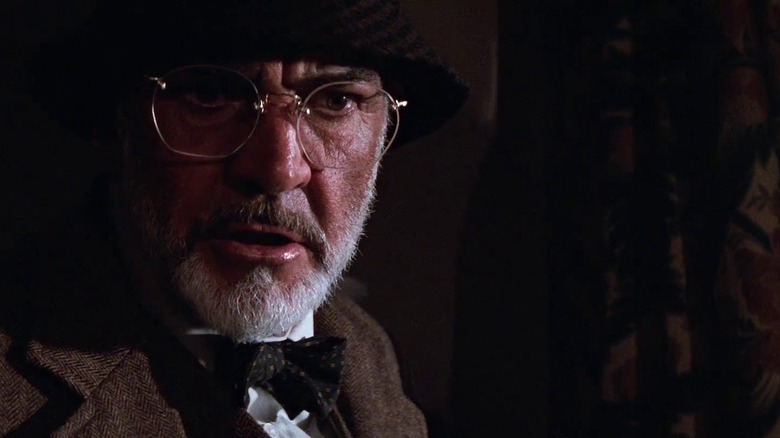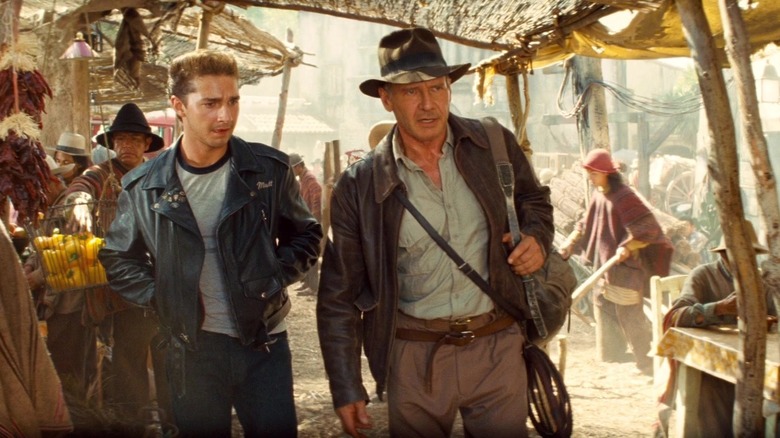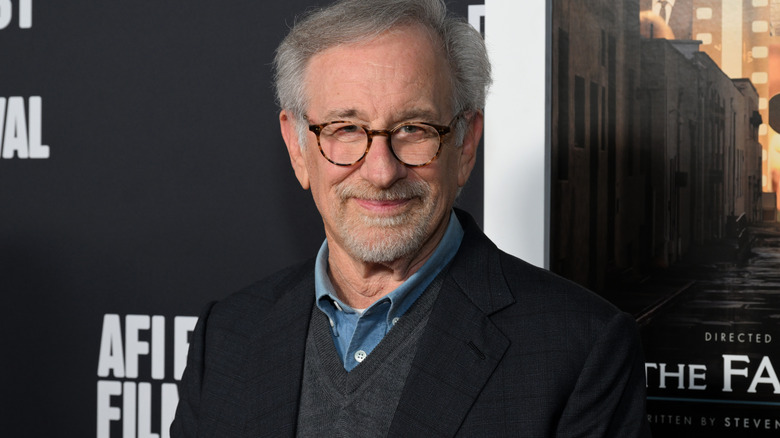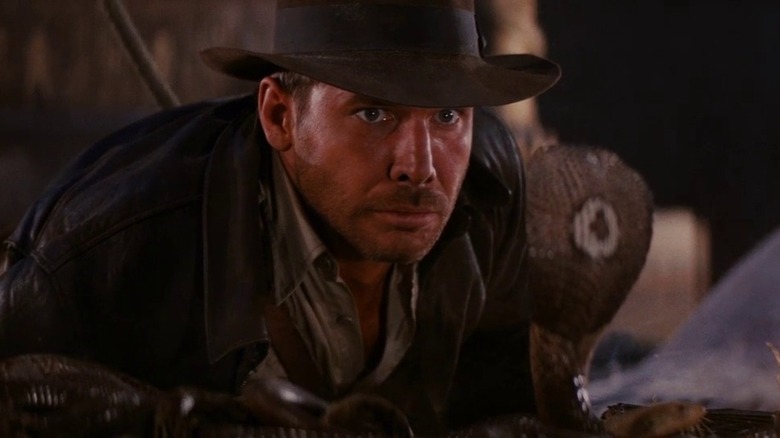The Best And Worst Things In The Indiana Jones Franchise
There's a reason the "Indiana Jones" movies have become so iconic. The mixture of incredible practical effects, Steven Spielberg's assured direction, and the delightfully pronounced performances ensure that these films are — more often than not — the kind of exciting blockbusters you never forget. Put simply, they're rollicking fun rides that perfectly blend adventure and thrills in a way that is hard to replicate. "Raiders of the Lost Ark" — which kicked off the whole franchise — is an especially impressive piece of adventure movie filmmaking, and every detail is just impeccably-realized. However, just because the "Indiana Jones" series is incredibly influential, and home to some of the all-time great movie moments, doesn't mean that it is a franchise completely devoid of flaws.
Breaking down the best and worst elements of the series highlights that even the most legendary franchises can slip up, while also making you appreciate the qualities that made the movies so beloved in the first place. Grab your hat and your whip, and join us on an adventure as we take a look at the highs and lows of the "Indiana Jones" franchise.
Worst: Racism in Temple of Doom
There's no ignoring the problematic elements of Indy's second outing, "Temple of Doom." The German and Russian baddies of other "Indiana Jones" films are switched out for caricatures of characters hailing from India, and engaging in human sacrifices supposedly rooted in aspects of Hinduism. One of the most memorable sequences in the film sees Indiana Jones, Willie Scott, and other western characters eating food prepared by the native chefs, and involves fictitious dishes like monkey brains rather than actual food synonymous with the country. While it is played for laughs, the entire point of this set piece is for western viewers to gawk at the "weird" food — a discomforting notion that reflects the troubling racial elements of the entire movie.
Fascinatingly, "Temple of Doom" isn't just problematic when viewed through a modern lens. When it was released in 1984, David Sterritt of The Christian Science Monitor expressed disappointment over how the movie demonized people of color and treated foreign cultures. The criticisms over "Temple of Doom's" depictions of non-white people have existed for decades, and speak to how deeply flawed this aspect of the blockbuster is. While other "Indiana Jones" movies make you cheer, many of the uncomfortable elements in "Temple of Doom" will leave you with your face in your hands instead.
Best: Those John Williams scores
While there are many important players both on the screen and behind the scenes in the "Indiana Jones" franchise, arguably the most important star of these features is composer John Williams — who conjured up the instantly recognizable score. The main theme alone is enough to encapsulate how crucial he is to this saga. Hum a few of those notes and chances are everyone around you will be able to join in. It's an instantly recognizable piece of music that captures the sense of adventure perfectly.
Thankfully, the artistic gifts of Williams in these movies aren't limited to just the core theme. Throughout all four movies, Williams provides rousing compositions that accentuate the zippy and fun aesthetics of each adventure. Even a weaker installment in this franchise, such as "Temple of Doom," doesn't see him slacking off on his musical brilliance. Big set pieces in that film would be devoid of nearly all tension if they weren't accompanied by the compositions from Williams. He's not the only important artist who has worked on these movies, but Williams has proven to be an essential part of the "Indiana Jones" world, and it wouldn't be the same without him.
Worst: Kate Capshaw in Temple of Doom
The "Indiana Jones" franchise doesn't always deliver female characters that are rich with nuance or unique personalities. While Marion Ravenwood (Karen Allen) in "Raiders of the Lost Ark" endeared herself to audiences thanks to her chemistry with Indy, this wasn't a trend that continued. Unfortunately, the female lead of "Temple of Doom," Willie Scott (Kate Capshaw), is the nadir of female representation in this franchise. Scott is a nightclub singer that gets thrust into the primary plot of the film but she doesn't have much to do after that, as Indiana Jones and Short Round (Ke Huy Quan) try to foil the evil plot of Mola Ram (Amrish Puri).
Instead, Willie's discomfort with the world of adventuring is played for laughs by "Temple of Doom," with the movie seeming to relish in watching her scream in terror or disgust. There's just not much to the character and she ends up contributing very little to the overall plot. While the chemistry between Marion and Indy worked, the brief tease of Willie and our hero engaging in a romantic fling lands with a thud — in part due to how little this film seems to care about developing her as a character. It's not like the "Indiana Jones" films are overflowing with three-dimensional female characters, but even by this saga's standards, Willie is a poorly realized creation.
Best: All the violence
There's an unfair perception that Steven Spielberg only makes movies that are overly schmaltzy without any danger or darkness. However, just because Spielberg can nail a sentimental moment, doesn't mean he's incapable of including darker elements when the opportunity calls for it. Case in point: the over-the-top violence of the "Indiana Jones" adventures. The first three movies in particular are full of gloriously gruesome deaths that are incredibly fun to watch, and perfectly reinforce the old-school adventure vibe of the franchise.
"Raiders of the Lost Ark" is the best example of this without question — with moments like a burly henchman getting shredded by an airplane propeller. Of course, the movie's climax is where it reaches its apex of nastiness —with the villains all getting dispatched in an assortment of gruesome ways. Future installments would memorably keep up this tradition, including the disposal of the main baddie in "Last Crusade." These moments are especially fun knowing many of them were realized through incredible practical effects (via Empire), and there's truly nothing like seeing intricate makeup and innovative technology being used in this way.
Worst: The overabundance of CGI in Kingdom of the Crystal Skull
An "Indiana Jones" movie made in the 2000s was always going to be different from its predecessors — even though Steven Spielberg reportedly wanted it to be as close to the feeling of the original trilogy as possible (via CNET). The rules had changed for blockbuster movies since "Last Crusade" in 1989 — including how big-budget movies are filmed. Still, nobody could have imagined that "Kingdom of the Crystal Skull" would depart from its predecessors in such a severe manner when it came to visual effects, with the dazzling practical effects and miniatures of the first three films largely replaced by an avalanche of CGI.
Digital effects work is not innately the problem. It's often very necessary for small touch-ups in post-production, and visual effects artists specializing in this field are incredibly valuable. The trouble comes when movies like "Kingdom of the Crystal Skull" decide to just lather every scene in wall-to-wall CGI. Distractingly fake digital backgrounds were scattered all throughout the film, while scenes like Mutt Williams swinging through the trees with a pack of CGI monkeys were laughable thanks to their obvious artificiality. The original "Indiana Jones" movies had made the unbelievable seem tangible with the almost imperceptible visual effects wizardry. "Kingdom of the Crystal Skull," meanwhile, just made the world seem fake.
Best: Harrison Ford's performances
It's easy to take Harrison Ford's performances as Indiana Jones for granted. His role isn't a flashy one full of physical transformations or other big acting choices. Instead, Ford imbues the suave figure with a natural charm that doesn't obviously try to draw attention to how cool he is. Indiana Jones doesn't need to spend time convincing others he's ruthless and legendary — just the way he walks into a room communicates his reputation. Plus, Ford is often surrounded by more pronounced performances from comical supporting characters or stylized villains, which can distract from this leading man's gifts.
Such a subtle performance deserves an incredible amount of recognition, and it's impossible to imagine Indiana Jones without Ford. His famously detached attitude is such fun juxtaposed against the kind of ludicrous adventures that Indy always gets into. His line deliveries — which can alternate between being rife with palpable conviction to being disarmingly humorous — are always a treat, while Ford also seems to have terrific chemistry with all the other actors. Indiana Jones is a pop culture icon for a multitude of reasons, but one of the most important of these is Harrison Ford's unforgettable performance.
Worst: The dark tone of Temple of Doom
Often, the second film in a blockbuster movie franchise is the one that ramps up the darkness, with movies like "The Empire Strikes Back" and "Black Panther: Wakanda Forever" both tackling heavier themes and more somber tones compared to their respective predecessors. This approach was alive and well when it came to "Temple of Doom" — though this wasn't just about increasing the level of poignancy or embracing a gloomier ending. "Temple of Doom" is an undeniably bleak feature, often to a relentless and uncomfortable degree.
Part of the issue with "Temple of Doom" is how its plot revolves around child slavery and includes barely off-screen scenes of kids being tortured for failing to comply with orders. Darker storytelling can be fun, but just leaning into a story hinging on child slavery feels incongruous with the zippy adventure tone of the "Indiana Jones" franchise. The darkness of "Temple of Doom" was so pervasive and uncomfortable that even Spielberg was aware of this defect. The director openly expressed regrets over just how dark he'd made "Temple of Doom" saying, "It was too dark, too subterranean, and much too horrific" (via IGN).
Best: The nuke the fridge scene
There's no getting around how hated one particular scene in "Kingdom of the Crystal Skull" is (via CNN). This sequence concerns Indy evading certain death from a nuclear blast — a fate he avoids only by ducking into a nearby fridge. This kitchen appliance is thrust into the air and just out of reach of the nuclear blast, with Indy tumbling out of the fridge after it lands on the ground. It's a preposterous moment that's spawned countless internet memes and parodies in the years since "Kingdom of the Crystal Skull" was released. Despite its absurdity, this unforgettable moment in the film is still shockingly fun.
It's a ridiculous moment, no question about that, but it also fits right in with the inexplicable ways Indiana Jones and his comrades are always getting out of near-death scrapes. Rarely do these escape routes follow sensible logic, so why should similar set pieces in "Kingdom of the Crystal Skull" also adhere to reality? The final punchline of Indy coming face-to-face with a prairie dog after he emerges from the fridge is a comedic misstep for sure, but otherwise, this sequence maintains the enjoyable ludicrousness of this franchise.
Worst: Only one distinctive Crystal Skull baddie
In "Kingdom of the Crystal Skull," Indiana Jones transitions from punching Nazis to fighting the Russians. This primarily involves duking it out with Irina Spalko, played by Cate Blanchett. With her distinctive costume and hairdo making her instantly recognizable, Spalko is made in Blanchett's performance — with the Oscar-winning actor clearly relishing the chance to play such a goofy character. Unfortunately, she's the only major villain of note in this film — a strange step down from the previous movies which packed their respective stories with multiple memorable baddies.
"Raiders of the Lost Ark," for instance, found time for three major villains, unforgettable henchmen to duke it out with Indy, and even a traitorous Nazi monkey. "Temple of Doom" and "Last Crusade" similarly had no shortage of memorable adversaries for Indiana Jones and friends to face off against. "Kingdom of the Crystal Skull," meanwhile, struggles to create any kind of discernible antagonistic personalities beyond Spalko, and some anonymous goons. This makes the film a bit more of a slog to get through and means the occasional demises of the various Russian henchmen have no weight to them. Why should we cheer for the end of villains we never even knew in the most basic terms?
Best: Sean Connery's work in Last Crusade
Sean Connery made his sole appearance as Indy's father, Henry Jones Sr. in "Last Crusade," and this fresh ingredient in the franchise delivered some of the most entertaining moments of the entire series. Could any other actor have made lines like "she talks in her sleep!" land like Connery? Even better, his rapport with Harrison Ford was immensely entertaining, with the duo perfectly conveying the fractured father-and-son dynamic without ever sacrificing the series' trademark sense of fun.
In the middle of all these humorous lines and exchanges, Connery's performance is also integral to making the big emotional moment of "Last Crusade" click. This actor absolutely nails the delivery of the line "Indy ... let it go" in the movie's third act. In this single line, Connery's delivery and facial expressions perfectly capture the intended weight of this simple fatherly advice. Whether it was imbuing pathos into a scene or just delivering lines people are still quoting decades later, Connery undoubtedly brought his A-game to "Last Crusade."
Worst: Awkward tease of Mutt taking over Indiana Jones mantle
Having established their relationship in "Raiders of the Lost Ark," Indy and Marion Ravenwood finally tie the knot at the end of "Kingdom of the Crystal Skull." The final scene of this movie depicts the two at the altar, though their wedding gets interrupted by a gust of wind busting open the doors to the church. Indy's famous hat tumbles to the ground, landing at the feet of Mutt Williams (Shia LaBeouf). Mutt picks up the hat and is about to put it on before Indy grabs it and puts it back on. Mutt is left alone in the church, where he plays around with his knife while the credits roll.
The execution of this gag is solid in terms of camerawork, but in terms of writing, it's still a clumsy tip of the hat towards the idea of Mutt taking over as the leading man of this franchise. This closing moment has only gotten more awkward in the years since the film was released. Mutt Williams is not set to appear in the fifth "Indiana Jones" adventure (via Entertainment Weekly), rendering this final gag — teasing his enduring presence in the saga — as utterly pointless.
Best: Spielberg's direction of action sequences
Time and time again, Steven Spielberg has proven himself to be an absolute master of his craft. Across his decade-spanning career, Spielberg has shown a constant sense of control and craftsmanship in the field of filmmaking across a wide variety of genres. He's just as comfortable handling weighty dramas like "Schindler's List" as he is making unforgettable thrills in a blockbuster like "Jurassic Park." It's the latter gift that is glaringly apparent throughout the "Indiana Jones" adventures, as the delightfully absurd spectacle-driven sequences of this franchise allow Spielberg to demonstrate his technical prowess as a director.
Spielberg's gift for crisp camerawork is especially appreciated in movies like "Raiders of the Lost Ark," with the fistfights and evasion of booby traps always being clear on-screen — no matter how intense things get. There's also real propulsion in Spielberg's camerawork and a sense of energy that makes you feel like you're right there duking it out with the baddies next to our hero. Even in weaker "Indiana Jones" installments, Steven Spielberg shows some real skill. "Kingdom of the Crystal Skull," for example, has a terrific chase sequence spanning a diner and a college campus that's rife with clever camerawork choices. There are countless places you could turn to for proof of Spielberg's skills as a director, but the "Indiana Jones" movies are particularly fun examples.
Best: Standalone nature of individual movies
George Lucas — the producer of the "Indiana Jones" movies — created a pop culture phenomenon through the "Star Wars" franchise, which was all about interconnected narratives and an overarching story. The original three "Star Wars" movies — and the subsequent prequels and sequels — all linked together to form a tapestry of cinematic storytelling. While the "Indiana Jones" movies have recurring supporting characters and repeated themes and motifs, their approach to storytelling is very different.
Notably, the "Indiana Jones" titles largely function as standalone features and can be watched and enjoyed on their own. The villains don't stick around from one movie to the next — save for the off-screen presence of Adolf Hitler — nor do the stories have ripple effects that traverse outside the film's in which they appear. The episodic nature of Indy's adventures, ensures the films don't require as much pre-viewing knowledge or the same time investment that other blockbuster franchises do. It is a departure from the "Star Wars" approach to big-budget storytelling, but such uniqueness is one of the best parts of "Indiana Jones."
